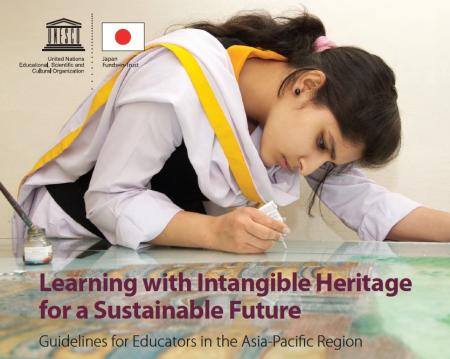ACTIONS
- Protect and safeguard cultural and natural heritage
- Learning and educational opportunities
- Cultural participation/social inclusion
- Sustainable tourism
- Support research
- Employment (recruiting, training, safety)
- Energy consumption, greenhouse gas emissions
- Waste management and reduction
- Transport (forms of, energy use)
- Commercial activities including copyright and IP
- Governance and management
- Security, disaster preparedness, risk reduction
- External partnerships and collaborations
- Publication/report
- Toolkit/framework/roadmap
- Case studies
Learning with Intangible Heritage for a Sustainable Future - Guidelines for Educators in the Asia-Pacific Region

Intended Audience
“The guide has been designed to be used by upper-elementary and lower-secondary school teachers, teacher educators in teacher education institutions, and curriculum development professionals. The guide would also be of interest to stakeholders from cultural institutions such as museums, cultural societies, heritage organizations and ICH non-governmental organizations (NGOs) and associations that are concerned with the continuity and vitality of local knowledge and practices.”
- J. Pillai, UNESCO Office Bangkok and Regional Bureau for Education in Asia and the Pacific
“This guide explains how the strategic incorporation of ICH elements and ESD principles into the curriculum can enable learners to gain the knowledge and skills that are necessary for ensuring sustainable development in the future.
The guide provides suggestions on how institutions like museums, cultural societies, heritage organizations and ICH NGOs can partner with schools to forward intergenerational transmission of ICH.” (p.8-9)
Avaiable in
- English
- Russian
- Uzbek
SDGs LINKAGES
This open-access resource mainly helps educators and teachers better deliver teaching activities and curricula related to intangible cultural heritage in lessons of different subjects, including both humanities and sciences. It covers SDG targets 4.1 (education activities for all children and teens), 4.5 (inclusion of gender perspectives and indigenous knowledge), 4.7 (appreciation of cultural diversity), 5.1 (case studies that cover role of women and girls in ICH, 11.4 (safeguard ICH), 16.7 (inclusive and participatory education approaches), 17.9 (call for partnerships and collaborations among local groups and countries in the Asia-Pacific), 17.16 (partnerships to support developing countries in achieving SDGs).
Click on the SDG Target to discover Our Collections Matter indicators
-
Our Collections Matter indicators:
- Number of programmes drawing on collections that support children at risk of exclusion or otherwise not completing primary and secondary education.
-
Our Collections Matter indicators:
- Number of educational and/or training programmes drawing on collections directed to eliminate gender disparities in education.
- Number of educational and/or training programmes drawing on collections directed to meet the particular needs of persons with disabilities.
- Number of educational and/or training programmes drawing on collections directed to meet the particular needs of Indigenous peoples’ groups.
- Number of educational and/or training programmes drawing on collections directed to meet the particular needs of children in vulnerable situations.
-
Our Collections Matter indicators:
- Numbers of people in each type of programme drawing on collections from different demographic groups.
- Increases in numbers of people in each type of programme from different demographic groups.
- Proportion of people involved in such programmes in relation to overall audience size.
- Evidence that learners have acquired knowledge and skills to promote sustainable development.
-
Our Collections Matter indicators:
- Collections development to ensure that collections effectively meet the needs of all, irrespective of sex or gender.
- Number and proportion of educational and participatory programmes that promote participation irrespective of sex or gender.
- Numbers and proportions of girls, women and gender-diverse people making use of collections in relation to the demographic of the local population.
- Numbers and proportions of girls, women and gender-diverse people involved in focused programmes aimed at promoting social, economic and political inclusion.
- Numbers and proportions of girls, women and gender-diverse people from different demographic groups involved in decision-making processes relating to collections and collections-based institutions.
- Number and types of partnerships that build relationships with people of different sex and gender.
-
Our Collections Matter indicators:
- Total expenditure (public and private) per capita spent on the preservation, protection and conservation of all cultural and natural heritage, by type of heritage.
- Plans, policies and procedures in place for the safe use of collections for a variety of purposes, protecting and safeguarding both collections and those who use them.
- Plans, policies and procedures in place for the identification, safeguarding and protection of cultural and natural heritage at risk.
- Collecting programmes in place to protect, safeguard and make use of cultural and natural heritage, addressing the needs of communities and stakeholders, and ensuring that collections can be an effective resource for sustainable development.
- Number and diversity of educational, awareness-raising, research programmes, and partnerships that aim to strengthen protection of cultural and natural heritage.
-
Our Collections Matter indicators:
- Proportions of positions (by sex, age, persons with disabilities and population groups) in public institutions (national and local legislatures, public service, and judiciary) compared to national distributions.
- Proportion of population [audience/users/non-users] who believe decision-making is inclusive and responsive, by sex, age, disability and population group.
- Decision-making addresses societal, environmental and economic challenges related to the community, considering short-term and long-term risks and opportunities.
- Decision-making draws on diverse backgrounds, viewpoints and interests, reflecting a broad base of stakeholders, and working to promote inclusion and provide effective services for all of society.
-
Our Collections Matter indicators:
- Number and diversity of international capacity-building activities to aid implementation of each and all of the SDGs.
- Number and diversity of North-South, South-South, and/or triangular co-operations and partnerships to aid implementation of each and all of the SDGs.
-
Our Collections Matter indicators:
- Number and/or increase in number, and diversity of global and international multi-stakeholder partnerships that share collection-related knowledge, expertise, technology and financial resources to address the SDGs, or that otherwise involve collections-based organisations and institutions.
- Number and/or increase in number, and diversity of global and international multi-stakeholder partnerships involving developing countries that share collection-related knowledge, expertise, technology and financial resources to address the SDGs.
